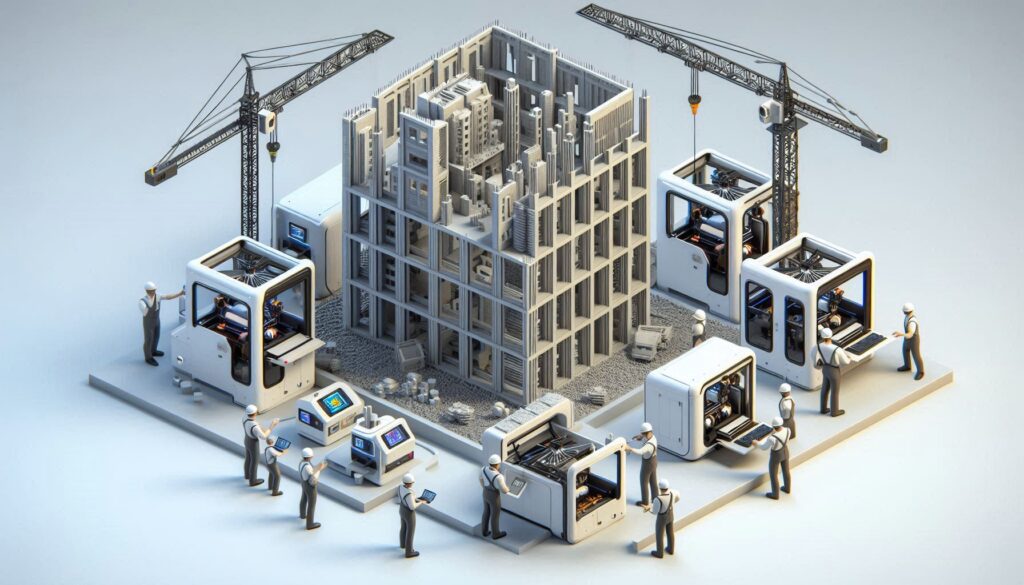3D Printing in Construction has progressed a lot till now.

3D Printing in Construction 2024: Transforming the Industry
The construction industry, traditionally known for its labor-intensive and resource-heavy practices, is undergoing a significant transformation with the advent of 3D printing technology. As we progress through 2024, 3D printing, or additive manufacturing, is emerging as a revolutionary force in construction, promising to reshape how buildings and infrastructure are designed, constructed, and maintained. This article delves into the advancements, applications, and impact of 3D printing in construction in 2024.
Advancements in 3D Printing Technology
Material Innovation: In 2024, 3D printing technology has advanced beyond the use of simple plastics to incorporate a wide range of materials, including concrete, metals, and bio-based composites. These innovations allow for the creation of structurally sound and environmentally friendly construction components. High-performance materials like carbon fiber-reinforced polymers and ultra-high-performance concrete are enabling the construction of more durable and sustainable structures.
Large-Scale Printing: One of the most significant advancements is the ability to print large-scale structures. Large-scale 3D printers, some as tall as multi-story buildings, can print entire walls, floors, and even complete houses. This scalability has made 3D printing a viable option for constructing not only residential buildings but also commercial and industrial structures.
Speed and Precision: Modern 3D printers offer enhanced speed and precision. They can print complex geometries with high accuracy, significantly reducing construction time. What used to take months or even years can now be accomplished in a matter of days or weeks, without compromising on quality.
Applications of 3D Printing in Construction
Residential Housing: 3D printing is making waves in the housing sector by providing affordable and rapid housing solutions. In 2024, various projects around the world are successfully using 3D printing to address housing shortages and provide homes for low-income communities. These houses are not only cost-effective but also customizable, allowing for personalized designs and layouts.
Commercial and Industrial Buildings: The technology is also being used to construct commercial and industrial buildings. Warehouses, offices, and retail spaces are being printed with innovative designs that optimize space and functionality. 3D printing enables the creation of complex architectural features that are difficult and expensive to achieve with traditional construction methods.
Infrastructure Projects: Bridges, pedestrian walkways, and other infrastructure projects are benefiting from 3D printing. The technology allows for the rapid and precise construction of these structures, reducing the need for extensive labor and minimizing disruptions. For example, 3D-printed bridges can be assembled on-site in a fraction of the time it takes to build conventional ones.

Impact of 3D Printing on the Construction Industry
Cost Efficiency: One of the most significant impacts of 3D printing is cost reduction. By minimizing material waste, reducing labor costs, and accelerating construction timelines, 3D printing offers substantial financial savings. The ability to print on-demand also eliminates the need for large inventories and reduces transportation costs.
Environmental Sustainability: 3D printing in construction is inherently more sustainable than traditional construction methods. It uses only the necessary amount of material, reducing waste significantly. Moreover, the ability to use eco-friendly materials, such as recycled plastics and bio-based composites, further enhances the environmental benefits. This aligns with the growing emphasis on green building practices and sustainability in construction.
Design Flexibility and Innovation: The design possibilities with 3D printing in construction are virtually limitless. Architects and engineers can experiment with complex shapes and innovative designs that are challenging to achieve with conventional methods. This freedom fosters creativity and allows for the development of unique, aesthetically pleasing, and functional structures.

Enhanced Safety: Construction sites are hazardous, with risks of accidents and injuries. 3D printing reduces the need for manual labor, especially in dangerous tasks, thereby enhancing worker safety. The technology also allows for better planning and precision, reducing the likelihood of errors and rework.
Challenges and Future Prospects
Regulatory Hurdles: Despite its benefits, 3D printing in construction faces regulatory challenges. Building codes and standards need to evolve to accommodate this new technology. Ensuring the structural integrity and safety of 3D-printed buildings requires rigorous testing and certification processes.
Skill Development: The adoption of 3D printing necessitates a skilled workforce proficient in operating and maintaining 3D printers. Training programs and educational initiatives are essential to equip construction professionals with the necessary skills.
Scalability and Acceptance: While 3D printing is gaining traction, widespread acceptance and scalability remain challenges. Industry stakeholders need to be convinced of the technology’s reliability, efficiency, and cost-effectiveness. Collaborative efforts between technology providers, construction firms, and regulatory bodies are crucial for broader adoption.
Conclusion
In 2024, 3D printing stands at the forefront of the construction industry’s technological revolution. Its ability to offer cost-effective, sustainable, and innovative construction solutions is transforming how we build our homes, offices, and infrastructure. While challenges remain, the continuous advancements in 3D printing technology and its growing acceptance promise a future where construction is faster, greener, and more efficient. As the industry adapts to these changes, 3D printing will undoubtedly play a pivotal role in shaping the built environment of tomorrow.